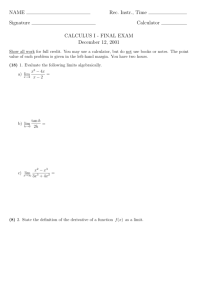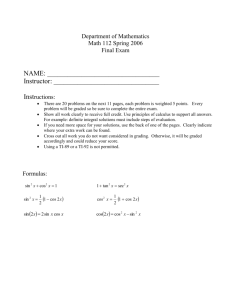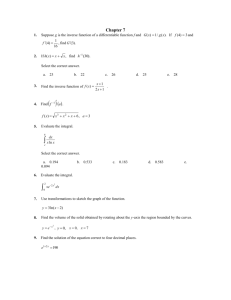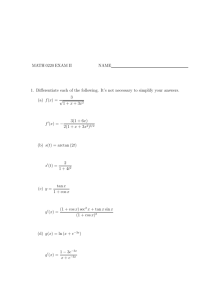Math 180, Final Exam, Study Guide Problem 1 Solution 1
advertisement
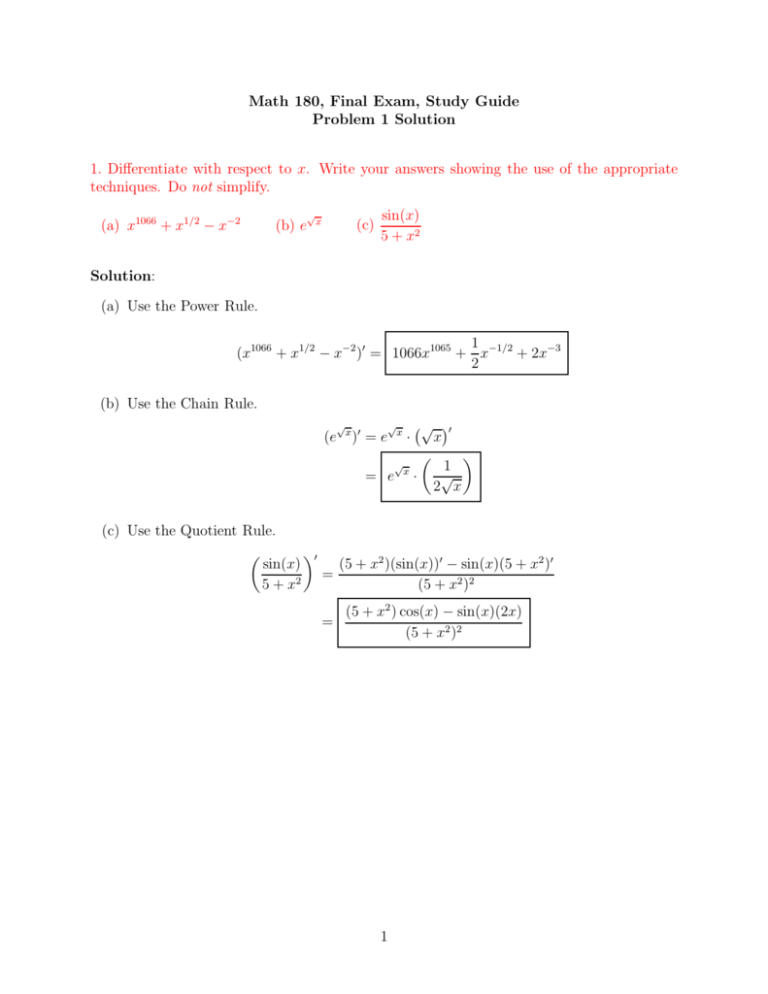
Math 180, Final Exam, Study Guide Problem 1 Solution 1. Differentiate with respect to x. Write your answers showing the use of the appropriate techniques. Do not simplify. (a) x1066 + x1/2 − x−2 √ (b) e x (c) sin(x) 5 + x2 Solution: (a) Use the Power Rule. 1 (x1066 + x1/2 − x−2 )′ = 1066x1065 + x−1/2 + 2x−3 2 (b) Use the Chain Rule. √ (e x ′ √ √ ′ x √ 1 x √ = e · 2 x ) =e x · (c) Use the Quotient Rule. ′ (5 + x2 )(sin(x))′ − sin(x)(5 + x2 )′ sin(x) = 5 + x2 (5 + x2 )2 = (5 + x2 ) cos(x) − sin(x)(2x) (5 + x2 )2 1 Math 180, Final Exam, Study Guide Problem 2 Solution 2. Differentiate with respect to x. Write your answers showing the use of the appropriate techniques. Do not simplify. 1 3x 2 (a) e cos(5x) (b) ln(x + x + 1) (c) tan x Solution: (a) Use the Product and Chain Rules. 3x ′ ′ e cos(5x) = e3x [cos(5x)]′ + e3x cos(5x) = e3x [−5 sin(5x)] + 3e3x cos(5x) (b) Use the Chain Rule. 1 · (x2 + x + 1)′ 2 x +x+1 1 = 2 · (2x + 1) x +x+1 ′ ln(x2 + x + 1) = (c) Use the Chain Rule. ′ ′ 1 1 1 2 tan · = sec x x x 1 1 2 · − 2 = sec x x 1 Math 180, Final Exam, Study Guide Problem 3 Solution 3. Differentiate with respect to x. Write your answers showing the use of the appropriate techniques. Do not simplify. (a) x2005 + x2/3 (b) cos(πx) (c) 1 + 2x 3 + x2 Solution: (a) Use the Power Rule. 2 (x2005 + x2/3 )′ = 2005x2004 + x−1/3 3 (b) Use the Chain Rule. [cos(πx)]′ = − sin(πx) · (πx)′ = − sin(πx) · (π) (c) Use the Quotient Rule. ′ (3 + x2 )(1 + 2x)′ − (1 + 2x)(3 + x2 )′ 1 + 2x = 3 + x2 (3 + x2 )2 = (3 + x2 )(2) − (1 + 2x)(2x) (3 + x2 )2 1 Math 180, Final Exam, Study Guide Problem 4 Solution 4. Differentiate with respect to x. Write your answers showing the use of the appropriate techniques. Do not simplify. (a) x2 e−3x (b) arctan(x) (c) ln(cos(x)) Solution: (a) Use the Product and Chain Rules. (x2 e−3x )′ = x2 (e−3x )′ + (x2 )′ e−3x = −3x2 e−3x + 2xe−3x (b) This is a basic derivative. (arctan(x))′ = 1 1 + x2 (c) Use the Chain Rule. [ln(cos(x))]′ = 1 · (cos(x))′ cos(x) 1 · (− sin(x)) cos(x) = 1 Math 180, Final Exam, Study Guide Problem 5 Solution 5. Use implicit differentiation to find the slope of the line tangent to the curve x2 + xy + y 2 = 7 at the point (2, 1). Solution: We must find dy using implicit differentiation. dx x2 + xy + y 2 = 7 d d d d 2 x + (xy) + y 2 = 7 dx dx dx dx dy dy 2x + x + y + 2y =0 dx dx dy dy = −2x − y x + 2y dx dx dy (x + 2y) = −2x − y dx −2x − y dy = dx x + 2y The value of dy at (2, 1) is the slope of the tangent line. dx −2(2) − 1 dy 5 = =− dx (2,1) 2 + 2(1) 4 An equation for the tangent line at (2, 1) is then: 5 y − 1 = − (x − 2) 4 1 Math 180, Final Exam, Study Guide Problem 6 Solution 6. Use calculus to find the exact x- and y-coordinates of any local maxima, local minima, and inflection points of the function f (x) = x3 − 12x + 5. Solution: The critical points of f (x) are the values of x for which either f ′ (x) does not exist or f ′ (x) = 0. Since f (x) is a polynomial, f ′ (x) exists for all x ∈ R so the only critical points are solutions to f ′ (x) = 0. f ′ (x) = 0 ′ x3 − 12x + 5 = 0 3x2 − 12 = 0 3(x2 − 4) = 0 3(x − 2)(x + 2) = 0 x = ±2 Thus, x = ±2 are the critical points of f . We will use the First Derivative Test to classify the points as either local maxima or a local minima. We take the domain of f (x) and split it into the intervals (−∞, −2), (−2, 2), and (2, ∞) and then evaluate f ′ (x) at a test point in each interval. Interval Test Number, c f ′ (c) Sign of f ′ (c) (−∞, −2) −3 f ′ (−3) = 15 + (−2, 2) 0 f ′ (0) = −12 − (2, ∞) 3 f ′ (3) = 15 + Since the sign of f ′ (x) changes sign from + to − at x = −2, the point f (−2) = 21 is a local maximum and since the sign of f ′ (x) changes from − to + at x = 2, the point f (2) = −11 is a local minimum. The critical points of f (x) are the values of x where f ′′ (x) changes sign. To determine these we first find the values of x for which f ′′ (x) = 0. f ′′ (x) = 0 ′ 3x2 − 12 = 0 6x = 0 x=0 We now take the domain of f (x) and split it into the intervals (−∞, 0) and (0, ∞) and then evaluate f ′′ (x) at a test point in each interval. 1 Interval Test Number, c f ′′ (c) Sign of f ′′ (c) (−∞, 0) −1 f ′′ (−1) = −6 − (0, ∞) 1 f ′′ (1) = 6 + We see that f ′′ (x) changes sign at x = 0. Thus, x = 0 is an inflection point. 2 Math 180, Final Exam, Study Guide Problem 7 Solution 7. Use calculus to find the x- and y-coordinates of any local maxima, local minima, and inflection points of the function f (x) = xe−x on the interval 0 ≤ x < ∞. The y-coordinates may be written in terms of e or as a 4-place decimal. Solution: The critical points of f (x) are the values of x for which either f ′ (x) does not exist or f ′ (x) = 0. Since f (x) is a polynomial, f ′ (x) exists for all x ∈ R so the only critical points are solutions to f ′ (x) = 0. f ′ (x) = 0 ′ xe−x = 0 −xe−x + e−x = 0 e−x (−x + 1) = 0 −x + 1 = 0 x=1 Thus, x = 1 is the only critical point of f . We will use the Second Derivative Test to classify it. f ′′ (x) = −e−x + xe−x − e−x = e−x (x − 2) At x = 1 we have f ′′ (1) = −e−1 < 0. Thus, the Second Derivative Test implies that f (1) = e−1 is a local maximum. The critical points of f (x) are the values of x where f ′′ (x) changes sign. To determine these we first find the values of x for which f ′′ (x) = 0. f ′′ (x) = 0 e−x (x − 2) = 0 x−2 =0 x=2 We now take the domain of f (x) and split it into the intervals (−∞, 2) and (2, ∞) and then evaluate f ′′ (x) at a test point in each interval. Interval Test Number, c f ′′ (c) Sign of f ′′ (c) (−∞, 2) 0 f ′′ (0) = −2 − (2, ∞) 3 f ′′ (3) = e−3 + We see that f ′′ (x) changes sign at x = 2. Thus, x = 2 is an inflection point. The corresponding value of f is f (2) = 2e−2 . 1 Math 180, Final Exam, Study guide Problem 8 Solution 8. Estimate the integral Z 40 f (t) dt using the left Riemann sum with four subdivisions. Some 0 values of the function f are given in the table: t f (t) 0 10 20 5.3 5.1 4.6 30 40 3.7 2.3 If the function f is known to be decreasing, could the integral be larger than your estimate? Explain why or why not. Solution: In calculating L4 , the value of ∆x is: ∆x = b−a 40 − 0 = = 10 N 4 The integral estimates are then: L4 = ∆x [f (0) + f (10) + f (20) + f (30)] = 10 [5.3 + 5.1 + 4.6 + 3.7] = 187 Since f is known to be decreasing, we know that R4 ≤ S ≤ L4 where S is the actual value of the integral. Therefore, the actual value of the integral cannot be larger than L4 . 1 Math 180, Final Exam, Study Guide Problem 9 Solution 9. Write the integral which gives the area of the region between x = 0 and x = 2, above the x-axis, and below the curve y = 9 − x2 . Evaluate your integral exactly to find the area. Solution: The area of the region is given by the integral: Z 2 (9 − x2 ) dx 0 We use FTC I to evaluate the integral. Z 0 2 2 x3 (9 − x ) dx = 9x − 3 0 03 23 − 9(0) − = 9(2) − 3 3 2 = 46 3 1 Math 180, Final Exam, Study Guide Problem 10 Solution 10. Write the integral which gives the area of the region between x = 1 and x = 3, above the 1 x-axis, and below the curve y = x − 2 . Evaluate your integral exactly to find the area. x Solution: The area is given by the integral: Z 3 1 x − 2 dx x 1 Using FTC I, we have: Z 1 3 3 x2 1 1 + x − 2 dx = x 2 x 1 2 2 3 1 1 1 = − + + 2 3 2 1 = 10 3 1 Math 180, Final Exam, Study Guide Problem 11 Solution 11. The average value of the function f (x) on the interval a ≤ x ≤ b is 1 b−a Z b f (x) dx a Find the average value of the function f (x) = 1 on the interval 2 ≤ x ≤ 6. x2 Solution: The average value is 1 6−2 Z 2 6 6 1 1 1 − dx = x2 4 x 2 1 1 1 = − − − 4 6 2 = 1 1 12 Math 180, Final Exam, Study Guide Problem 12 Solution 12. Find lim √ x→0 1+x−1 x Explain how you obtain your answer. Solution: Upon substituting x = 0 into the function f (x) = √ 1+x−1 = x √ √ 1+x−1 we find that x 0 1+0−1 = 0 0 which is indeterminate. We can resolve the indeterminacy by multiplying f (x) by the “conjugate” of the numerator divided by itself. √ √ √ 1+x−1 1+x−1 1+x+1 = lim ·√ lim x→0 x→0 x x 1+x+1 (1 + x) − 1 = lim √ x→0 x( 1 + x + 1) x = lim √ x→0 x( 1 + x + 1) 1 = lim √ x→0 1+x+1 1 =√ 1+0+1 = 1 2 1 Math 180, Final Exam, Study Guide Problem 13 Solution 13. Find lim x→0 1 − cos(3x) x2 Explain how you obtain your answer. Solution: Upon substituting x = 0 into the function we find that 1 − cos(3 · 0) 0 1 − cos(3x) = = x2 02 0 which is indeterminate. We resolve this indeterminacy by using L’Hôpital’s Rule. lim x→0 (1 − cos(3x))′ 1 − cos(3x) L′ H = lim x→0 x2 (x2 )′ 3 sin(3x) = lim x→0 2x 3 sin(3x) = lim 2 x→0 x This limit has the indeterminate form 0 0 so we use L’Hôpital’s rule again. 3 sin(3x) L′ H 3 (sin(3x))′ = lim lim 2 x→0 x 2 x→0 (x)′ 3 cos(3x) 3 = lim x→0 2 1 3 3 cos(3 · 0) = · 2 1 9 = 2 1 Math 180, Exam 2, Study Guide Problem 14 Solution 14. The graph below represents the derivative, f 0 (x). (i) On what interval is the original f decreasing? (ii) At which labeled value of x is the value of f (x) a global minimum? (iii) At which labeled value of x is the value of f (x) a global maximum? (iv) At which labeled values of x does y = f (x) have an inflection point? Solution: (i) f is decreasing when f 0 (x) < 0. From the graph, we can see that f 0 (x) < 0 on the interval (a, c). Rx (ii) We know that f (x) = f (0) + 0 f 0 (t) dt. That is, f (x) is the signed area between y = f 0 (x) and the x-axis on the interval [0, x] plus a constant. Thus, the global minimum of f (x) will occur when the signed area is a minimum. This occurs at x = c. (iii) The global maximum of f (x) will occur when the signed area is a maximum. This occurs at x = e. (iv) An inflection point occurs when f 00 (x) changes sign, i.e. when f 0 (x) transitions from increasing to decreasing or vice versa. This occurs at x = b and x = d. 1 Math 180, Final Exam, Study Guide Problem 15 Solution 15. The function f (x) has the following properties: • f (5) = 2 • f ′ (5) = 0.6 • f ′′ (5) = −0.4 (a) Find the tangent line to y = f (x) at the point (5, 2). (b) Use (a) to estimate f (5.2). (c) If f is known to be concave down, could your estimate in (b) be greater than the actual f (5.2)? Give a reason supporting your answer. Solution: (a) The slope of the tangent line at the point (5, 2) is f ′ (5) = 0.6. Thus, an equation for the tangent line is: y − 2 = 0.6(x − 5) (b) The tangent line gives the linearization of f (x) at x = 2. That is, L(x) = 2 + 0.6(x − 5) Thus, an approximate value of f (5.2) using the linearization is: f (5.2) ≈ L(5.2) = 2 + 0.6(5.2 − 5) = 2.12 (c) If f is concave down then the tangent line at x = 5 is always above the graph of y = f (x) except at x = 5. Thus, if we use the tangent line to approximate f (5.2), the estimate will give us a value that is greater than the actual value of f (5.2). 1 Math 180, Final Exam, Study Guide Problem 16 Solution 16. The point (x, y) lies on the curve y = √ x. (a) Find the distance from (x, y) to (2, 0) as a function f (x) of x alone. (b) Find the value of x that makes this distance the smallest. Solution: The function we seek to minimize is the distance between (x, y) and (2, 0). p Function : Distance = (x − 2)2 + (y − 0)2 √ The constraint in this problem is that the point (x, y) must lie on the curve y = x. √ Constraint : y= x (1) (2) Plugging this into the distance function (1) and simplifying we get: q 2 √ x−0 Distance = (x − 2)2 + √ f (x) = x2 − 3x + 4 We want to find the absolute minimum of f (x) √ on the interval [0, ∞). We choose this interval because (x, y) must be on the line y = x and the domain of this function is [0, ∞). The absolute minimum of f (x) will occur either at a critical point of f (x) in (0, ∞), at x = 0, or it will not exist. The critical points of f (x) are solutions to f 0 (x) = 0. f 0 (x) = 0 h 1/2 i0 x2 − 3x + 4 =0 −1/2 0 1 2 x − 3x + 4 · x2 − 3x + 4 = 0 2 2x − 3 √ =0 2 x2 − 3x + 4 2x − 3 = 0 3 x= 2 1 Plugging this into f (x) we get: √ s 2 3 3 3 7 f = −3 +4= 2 2 2 2 Evaluating f (x) at x = 0 and taking the limit as x → ∞ we get: p f (0) = 02 − 3(0) + 4 = 2 √ lim f (x) = lim x2 − 3x + 4 = ∞ x→∞ x→∞ √ both of which are larger than 7 . 2 We conclude that the distance is an absolute minimum √ 3 and that the resulting distance is 27 . The last step is to find the corresponding 2 value for y by plugging x = 23 into equation (2). at x = r y= 2 3 2 Math 180, Final Exam, Study Guide Problem 17 Solution 17. You have 24 feet of rabbit-proof fence to build a rectangular garden using one wall of a house as one side of the garden and the fence on the other three sides. What dimensions of the rectangle give the largest possible area for the garden? Solution: We begin by letting x be the length of the side opposite the house and y be the lengths of the remaining two sides. The function we seek to minimize is the area of the garden: Function : Area = xy (1) The constraint in this problem is that the length of the fence is 24 feet. Constraint : x + 2y = 24 (2) Solving the constraint equation (2) for y we get: y = 12 − x 2 (3) Plugging this into the function (1) and simplifying we get: x Area = x 12 − 2 1 2 f (x) = 12x − x 2 We want to find the absolute maximum of f (x) on the interval [0, 24]. The absolute maximum of f (x) will occur either at a critical point of f (x) in [0, 24] or at one of the endpoints of the interval. The critical points of f (x) are solutions to f 0 (x) = 0. f 0 (x) = 0 0 1 2 12x − x =0 2 12 − x = 0 x = 12 1 Plugging this into f (x) we get: 1 f (12) = 12(12) − (12)2 = 72 2 Evaluating f (x) at the endpoints we get: 1 f (0) = 12(0) − (0)2 = 0 2 1 f (24) = 12(24) − (24)2 = 0 2 both of which are smaller than 72. We conclude that the area is an absolute maximum at x = 12 and that the resulting area is 72. The last step is to find the corresponding value for y by plugging x = 12 into equation (3). y = 12 − 12 x = 12 − = 6 2 2 2 Math 180, Final Exam, Study Guide Problem 18 Solution 18. Evaluate the integral Z xex 2 −1 dx. Solution: We use the substitution u = x2 − 1, 12 du = x dx. Making the substitutions and evaluating the integral we get: Z Z 1 x2 −1 xe dx = eu du 2 1 = eu + C 2 1 2 = ex −1 + C 2 1 Math 180, Final Exam, Study Guide Problem 19 Solution 19. Evaluate the integral Z sin2 cos x dx. Solution: We use the substitution u = sin x, du = cos x dx. Making the substitutions and evaluating the integral we get: Z Z 2 sin x cos x dx = u2 du = = 1 u3 +C 3 sin3 x +C 3 Math 180, Final Exam, Study Guide Problem 20 Solution 20. Evaluate Z 5 2 √ 2x − 3 dx. x2 − 3x + 6 Solution: We use the substitution u = x2 −3x+6, du = (2x−3) dx. The limits of integration become u = 22 − 3(2) + 6 = 4 and u = 52 − 3(5) + 6 = 16. Making the substitutions and evaluating the integral we get: Z 5 Z 16 2x − 3 1 √ √ du dx = u x2 − 3x + 6 2 4 16 √ =2 u √ 4 √ = 2 16 − 2 4 = 4 1


